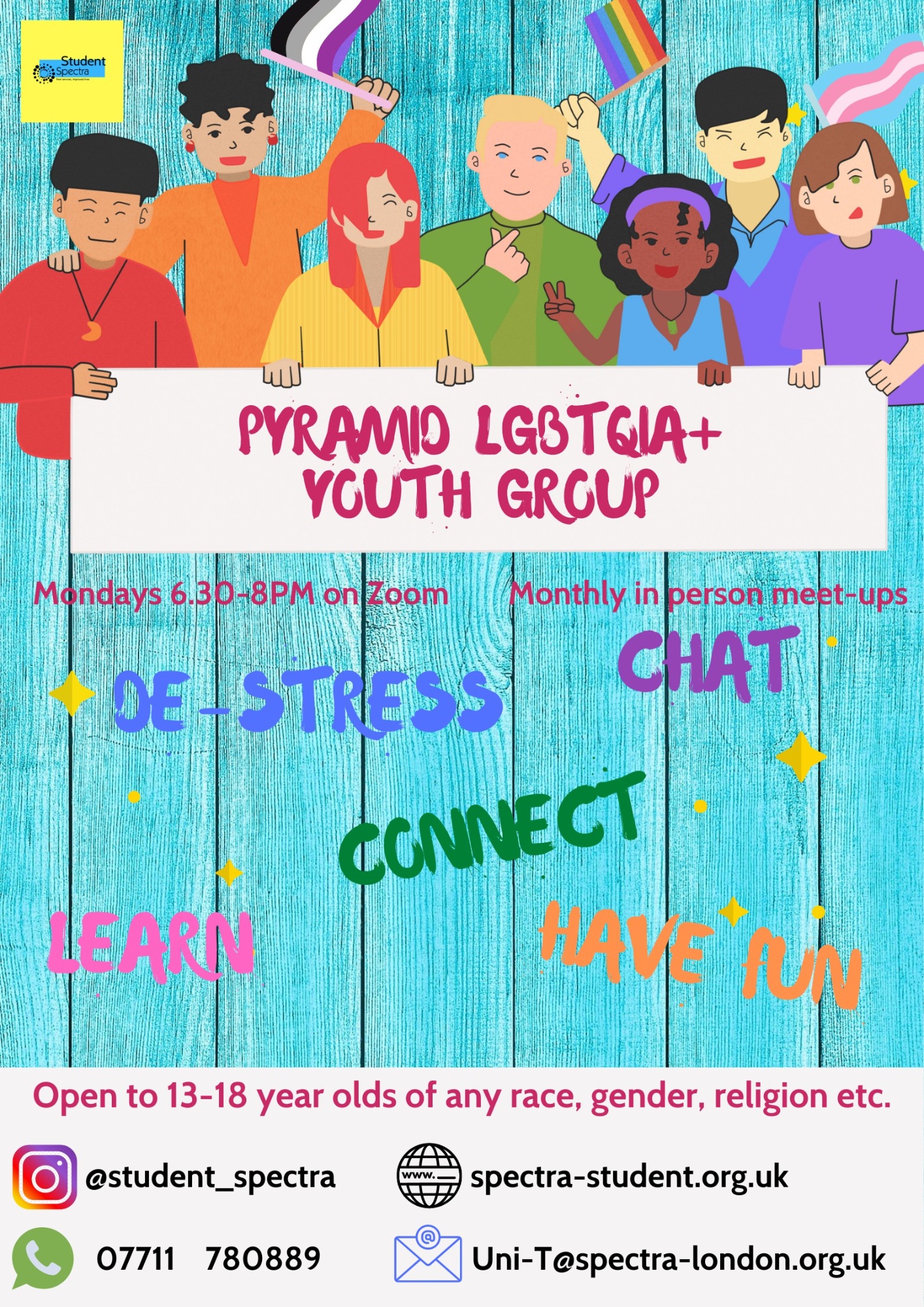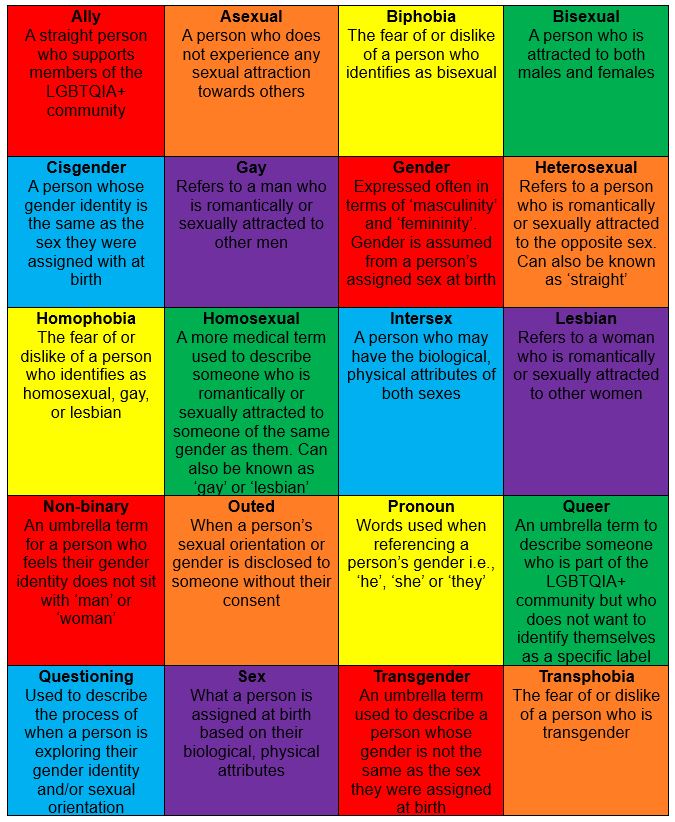LGBTQIA+


Key Terminology
Asexual (Ace)
A person who does not experience sexual attraction. Some asexual people experience romantic attraction, while others do not. Asexual people who experience romantic attraction might also use terms such as gay, bi, lesbian, straight and queer in conjunction with asexual to describe the direction of their romantic attraction.
Ally
A (typically) straight and/or cis person who supports members of the LGBTQIA+ community.
Bisexual (Bi)
Bi is an umbrella term used to describe a romantic and/or sexual orientation towards more than one gender.
Cisgender (Cis)
Someone whose gender identity is the same as the sex they were assigned at birth. Non-trans is also used by some people.
Coming out
When a person first tells someone/others about their orientation and/or gender identity.
Dead naming
Calling someone by their birth name after they have changed their name. This term is often associated with trans people who have changed their name as part of their transition.
Gay
Refers to a man who has a romantic and/or sexual orientation towards men. Some women may also define themselves as gay rather than lesbian. Some non-binary people may also identify with this term.
Gender
Often expressed in terms of masculinity and femininity, gender is largely culturally/socially determined and is assumed from the sex assigned at birth.
Gender dysphoria
Used to describe when a person experiences discomfort or distress because there is a mismatch between their sex assigned at birth and their gender identity. This is also the clinical diagnosis for someone who doesn’t feel comfortable with the sex they were assigned at birth.
Gender identity
A person’s innate sense of their own gender, whether male, female or something else (see non-binary below), which may or may not correspond to the sex assigned at birth.
Gender reassignment
Another way of describing a person’s transition. To undergo gender reassignment usually means to undergo some sort of medical intervention, but it can also mean changing names, pronouns, dressing differently and living in their self-identified gender.
Heterosexual/Straight
Refers to a man who has a romantic and/or sexual orientation towards women or to a woman who has a romantic and/or sexual orientation towards men.
Homophobia
The fear or dislike of someone, based on prejudice or negative attitudes, beliefs or views about lesbian, gay or bi people. Homophobic bullying may be targeted at people who are, or who are perceived to be, lesbian, gay or bi.
Intersex
A term used to describe a person who may have the biological attributes of both sexes or whose biological attributes do not fit with societal assumptions about what constitutes male or female.
Intersex people may identify as male, female or non-binary.
Lesbian
Refers to a woman who has a romantic and/or sexual orientation towards women. Some non-binary people may also identify with this term.
Non-binary
An umbrella term for people whose gender identity doesn’t sit comfortably with ‘man’ or ‘woman’. Non-binary identities are varied and can include people who identify with some aspects of binary identities, while others reject them entirely.
Outed
When a lesbian, gay, bi or trans person’s sexual orientation or gender identity is disclosed to someone else without their consent.
Pansexual (Pan)
Refers to a person whose romantic and/or sexual attraction towards others is not limited by sex or gender.
Passing
If someone is regarded, at a glance, to be a cisgender man or cisgender woman.
Cisgender refers to someone whose gender identity matches the sex they were ‘assigned’ at birth. This might include physical gender cues (hair or clothing) and/or behaviour which is historically or culturally associated with a particular gender.
Pronoun
Words we use to refer to people’s gender in conversation - for example, ‘he’ or ‘she’. Some people may prefer others to refer to them in gender neutral language and use pronouns such as they/them.
Queer
Queer is a term used by those wanting to reject specific labels of romantic orientation, sexual orientation and/or gender identity. Although some LGBT people view the word as a slur, it was reclaimed in the late 80s by the queer community who have embraced it.
Questioning
The process of exploring your own sexual orientation and/or gender identity.
Sex
Assigned to a person on the basis of primary sex characteristics (genitalia) and reproductive functions. Sometimes the terms ‘sex’ and ‘gender’ are interchanged to mean ‘male’ or ‘female’.
Sexual orientation
A person’s sexual attraction to other people, or lack thereof.
The term ‘orientation’ can also be used as an umbrella term covering sexual and romantic orientations.
Transgender (Trans)
An umbrella term to describe people whose gender is not the same as, or does not sit comfortably with, the sex they were assigned at birth.
Trans people may describe themselves using one or more of a wide variety of terms, including (but not limited to) transgender, transsexual, gender-queer (GQ), gender-fluid, non-binary, gender-variant, genderless, agender, nongender, third gender, bi-gender, trans man, trans woman.
Transitioning
The steps a trans person may take to live in the gender with which they identify. Each person’s transition will involve different things. For some this involves medical intervention, such as hormone therapy and surgeries, but not all trans people want or are able to have this.
Transitioning also might involve things such as telling friends and family, dressing differently and changing official documents.
Transphobia
The fear or dislike of someone based on the fact they are trans, including denying their gender identity or refusing to accept it. Transphobia may be targeted at people who are, or who are perceived to be, trans.

